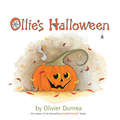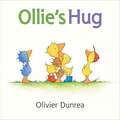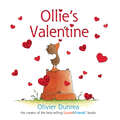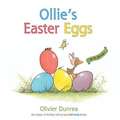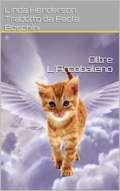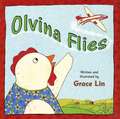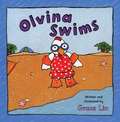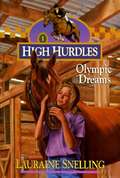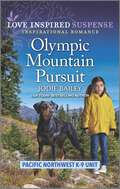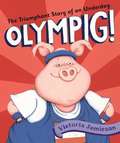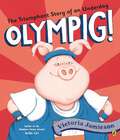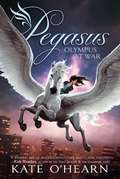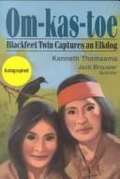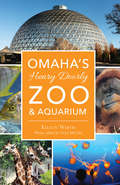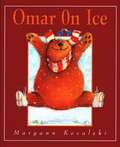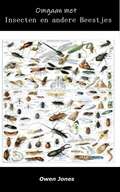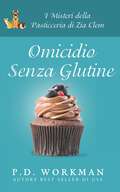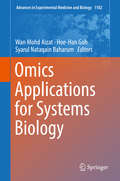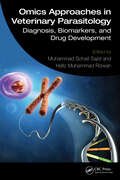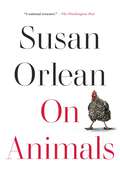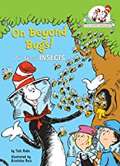- Table View
- List View
Ollie's Halloween (Gossie & Friends)
by Olivier DunreaThis Halloween, Gossie is a wizard and Gertie is a chicken. Peedie is a dragon and BooBoo is a bunny. Ollie is a mummy who thinks sharing is more fun than scaring. Join the goslings as they hoot, howl, and haunt the night away. Goslings are on the prowl!
Ollie's Hug (Gossie & Friends)
by Olivier DunreaWhen Ollie is in a grumpy mood and nothing feels right, a hug from a friend does the trick! The perfect book for little kids with big feelings.
Ollie's Valentine (Gossie & Friends)
by Olivier DunreaA new book in Olivier Dunrea's Gossie & Friends series! Ollie is looking. Looking for a valentine. Gossie, Gertie, Peedie, and BooBoo all have valentines, but Ollie wonders who will be his. His search leads him to a special valentine of his very own--a surprise for Ollie and readers! Dunrea's charming artwork shines in this treat of a book.
Ollies Easter Eggs
by Olivier DunreaGossie, Gertie, BooBoo, and Peedie are all dyeing Easter eggs. Ollie wants Easter eggs too and he has a plan on how he'll get them! Humor and vibrant ink-and-watercolor illustrations fill Olivier Dunrea's holiday follow-up to Merry Christmas, Ollie. Dunrea again gets the preschooler emotions exactly right, capturing a range of holiday-inspired feelings, from Ollie's wiggly impatience to be included to the pure joy of the older goslings discovering that Ollie has arranged the best Easter egg hunt of all. Includes sheet of colorful stickers!
Oltre L'Arcobaleno
by Linda HendersonVi siete mai chiesti cosa succede ai vostri animali domestici dopo la morte? Sarai mai in grado di rivederli? Beh, la buona notizia e "Si." Gli animali domestici che sono veramente amati dai loro proprietari vanno in Paradiso. E Dio vuole che vi riuniate a loro, se solo confiderete in Suo Figlio, Gesù, per salvarvi. Non siete mai troppo giovani per assicurare la vostra eternità in Cielo, o troppo vecchi. Questo libro, basato sugli insegnamenti biblici e su ciò a cui ai cristiani è stato dimostrato di esistere in Cielo, fu scritto per confortare specialmente i bambini, ma anche gli adulti. È per coloro il cui cane o gatto non è più con loro, e gli manca davvero. Speriamo che porti conforto ai vostri cuori!
Olvina Flies
by Grace LinWhen Olvina gets invited to the Tenth Annual Bird Convention in Hawaii, she decides it's high time to overcome her fear of flying. But on the day of her big plane trip, Olvina's tummy is filled with butterflies and she has second thoughts. After all, chickens aren't supposed to fly. Or are they? This tender and funny story is for children who love to fly as well as those who have not yet had the experience. From takeoff to landing, Olvina's journey is one kids won't want to miss!
Olvina Swims
by Grace LinOlvina the plucky chicken swims about as well as she flies. Which is to say, not at all (unless she is flying in an airplane!). Olvina's reluctance to swim hasn't been a problem until she is on vacation in Hawaii with her friend Hailey. Will Olvina let her fear of the water spoil her fun? Not with Hailey on the job. Children as well as chickens may find learning to swim a new and somewhat daunting challenge. This reassuring picture book shows that with a little courage, lots of practice, and the help of a good friend, you can accomplish just about anything.
Olympic Dreams (High Hurdles #1)
by Lauraine SnellingHIGH HURDLES 1 Thirteen-year-old DJ Randall wants nothing more than to compete as a show jumper in the Olympics. After years of riding and working with horses, she's ready to start contending. Only one obstacle stands in her way--she doesn't have a horse! Together with her best friend, Amy Yamamoto, DJ puts her plan for earning horse money into action. But just when it seems as if buying a horse is a real possibility, everything goes wrong. DJ's grandmother, who has always lived with DJ and her fast-track mother, announces she is moving out. Horrified at the prospect of living alone with a mother who doesn't understand her dreams, DJ fights to prevent the move. Without Gran's support, DJ may never realize her Olympic ambitions! All DJ needs is a chance . . .
Olympic Mountain Pursuit (Pacific Northwest K-9 Unit #4)
by Jodie BaileyCan this K-9 get a child to safety? Four years ago, former US Marshal Jackson Dean left his job after falling for a witness—who&’s suddenly the target of an assassin. Now it&’s up to Jackson and his K-9 partner to protect single mom Everly Lopez and her young daughter when Everly&’s identity is blown. But with hired killers looking for a payday, Jackson must use all his resources to stop them from silencing Everly permanently.From Love Inspired Suspense: Courage. Danger. Faith.Pacific Northwest K-9 Unit Book 1: Shielding the Baby by Laura ScottBook 2: Scent of Truth by Valerie HansenBook 3: Explosive Trail by Terri ReedBook 4: Olympic Mountain Pursuit by Jodie BaileyBook 5: Threat Detection by Sharon DunnBook 6: Cold Case Revenge by Jessica R. PatchBook 7: Undercover Operation by Maggie K. BlackBook 8: Snowbound Escape by Dana Mentink
Olympig!
by Victoria JamiesonPursued by Mr. Hamstring, a reporter who is sure he will fail, Boomer becomes the first pig ever to compete in the Animal Olympics and demonstrates that attitude can be more important than winning.
Olympig!
by Victoria JamiesonJust in time for the Olympics, a spirited, sporty romp about losing gracefully Boomer the Pig has been training hard for the Animal Olympics, so when he loses his first race, he shrugs it off and cheerfully moves on. One event after another, Boomer keeps losing, and the frustration begins to get to him. But even after coming in last in every sport, there's no getting this Olympig down. It's just great practice for the Winter Games! Cool comic book styling combines with classic picture book heart in this encouraging and hilarious story for every kid who's ever been told "you can't win 'em all."
Olympus at War (Pegasus #2)
by Kate O'HearnEmily and her winged horse face a war of Olympic proportions in this second book of an adventurous trilogy.Emily, newly recognized as the Flame, is living in Jupiter's palace on Mt. Olympus. Her friends, Joel, Paelen, and--of course--Pegasus, are there as well. The only person missing is Emily's father, who is still being held prisoner by the CRU back in the human world. Emily wants to go find him, but Jupiter won't allow her to leave. However, Emily does have access to a winged horse... Determined to rescue her father, Emily and her friends make plans to sneak away from Olympus and back to New York. Then Cupid, Emily's sort-of crush, decides to come along as well. It will be hard enough to hide a winged horse from the prying eyes of the CRU, but a winged boy as well? And when the gruesome Nirads begin a new invasion, old grudges are unearthed, new enemies are discovered, and Emily and her friends become entangled in a conflict more dangerous than they ever anticipated.
Om-kas-toe: Blackfoot Twin Captures Elkdog
by Kenneth ThomasmaTwins are born in the early 1700's to the Blackfeet people. It is customary for twins not to be kept alive. These twins' mother begs her people to allow her to keep her little girl, as well as her boy twin. The people agree, and the twins live impressive lives. Their greatest accomplishment is the act of introducing horses to their people.
Omaha’s Henry Doorly Zoo & Aquarium (Landmarks)
by Carol Mccabe Eileen WirthLong ranked as one of the top zoos in America and even the world, Omaha’s Henry Doorly Zoo & Aquarium’s history has remained untold, until now. Beginning as little more than a menagerie, the zoo transformed into a spectacular attraction that now draws two million visitors per year. Supporters responded to innovative features such as the iconic desert dome, the new African Grasslands exhibit, the indoor jungle and the all-encompassing aquarium. More than just a showcase, the zoo also supports renowned wildlife conservation and research programs that help preserve endangered species ranging from coral reefs to tigers. Author Eileen Wirth celebrates the history and promising future of the landmark that continues to elicit great local pride.
Omar On Ice
by Maryann KovalskiOmar loves drawing pictures and wishes he could be as good at it as his classmate Elsie. But his teacher, Ms. Fudge, can never figure out what Omar's pictures are--no matter how hard she tries. When the whole class goes ice skating, however, Omar's true talent emerges. He shows Elsie how he can glide and whirl and spin. After all, it's easy when you don't worry and just have fun. And the whole class discovers with Omar that there is more than one way to draw pictures.
Omar: A State Police Dog
by S. P. MeekBob Halliday refuses the idea that Omar, a German Shepherd dog, doesn't have what it takes to be a great police dog. After convincing the Commandant to let Bob keep Omar, Omar shows how smart he is. Can Omar help Bob in a shoot-out with a burglar?
Omgaan met insecten en andere beestjes (Hoe te... #65)
by Owen JonesOmgaan met insecten en andere beestjes Hartelijk dank voor het downloaden van dit e-book ‘Omgaan met insecten en andere beestjes’. Ik hoop dat je het de moeite waard vindt en er wat aan hebt. Het gaat over de verschillende kanten van het omgaan met insecten en halfvleugeligen, in het bijzonder in en rond je huis. Het boek is verdeeld over 16 hoofdstukken van elk 500 tot 600 woorden. Ik hoop dat het ook interessant is voor mensen die een beetje bang zijn voor insecten en voor mensen die de wat traditionelere middelen willen gebruiken om van ze af te komen bij overlast. Als bonus geef ik je toestemming om de inhoud te gebruiken voor bijvoorbeeld je eigen website, blog of tijdschrift. Herschrijf het dan liefst in je eigen woorden. Je mag ook een deel van het boek gebruiken om er je voordeel mee te doen in eigen publicaties. Het enige dat je niet mag, is het in z’n geheel doorverkopen of weggeven in de vorm zoals je het boek zelf hebt verkregen. Voor je feedback kun je terecht bij de wederverkoper waar je dit boek hebt gekocht. Je kunt daar ook andere boeken vinden over dit onderwerp. Nogmaals bedankt voor je aanschaf. Met vriendelijke groet, Owen Jones
Omicidio senza glutine (La Pasticceria Di Zia Clem #1)
by P. D. WorkmanErin Price si trasferisce a Bald Eagle Falls, un posto dove tutti conoscono tutti e gli affari di tutti, e decide di riaprire il negozio che le ha lasciato sua zia per avviare un forno senza glutine. La magnifica inaugurazione è rovinata da una sola cosa: la morte di Angela Plaint, la sua rivale in affari. Sembra che Angela sia stava avvelenata da uno dei muffin di Erin e questo la rende la sospettata principale. Armata di muffin, sete di verità e aiuto della nuova aiutante del forno, Vicky, Erin si lancia in un testa a testa contro l'agente Terry Piper per risolvere l'omicidio. Voci di cacce al tesoro, spaccio di droga e un ragazzo scomparso vorticano a Bald Eagle Falls mentre Erin cerca di evitare le false piste e trovare l'assassino prima che l'assassino metta le mani su di lei. ***** Un giallo cozy fantastico, ottimi la caratterizzazione e gli intrighi. Il finale è da restare con il fiato sospeso! ***** Questo è il primo libro di P.D. Workman che leggo e di certo non sarà l'ultimo. L'autrice ha la capacità di attirare nella storia e trattenere fino alla fine. I suoi personaggi sono interessanti e profondi. Non ha paura di esplorare aree della nostra società che molti preferirebbero spazzare sotto il tappeto. Invece, lei le inserisce nella storia per creare tensione e personaggi credibili. La tensione costruita dall'autrice nel finale mi tolto il respiro. Ti piacciono i misteri in cucina? I gatti, i cani e gli animali? P.D. Workman, autrice premiata e bestseller di USA Today, accompagna i lettori nel paesino di Bald Eagle Falls per un giallo cozy gastronomico da risolvere insieme alla pasticciera senza glutine Erin Price e ai suoi amici.
Omics Applications for Systems Biology (Advances in Experimental Medicine and Biology #1102)
by Wan Mohd Aizat Hoe-Han Goh Syarul Nataqain BaharumThis book explains omics at the most basic level, including how this new concept can be properly utilized in molecular and systems biology research. Most reviews and books on this topic have mainly focused on the technicalities and complexity of each omics’ platform, impeding readers to wholly understand its fundamentals and applications. This book tackles such gap and will be most beneficial to novice in this area, university students and even researchers. Basic workflow and practical guidance in each omics are also described, such that scientists can properly design their experimentation effectively. Furthermore, how each omics platform has been conducted in our institute (INBIOSIS) is also detailed, a comprehensive example on this topic to further enhance readers’ understanding. The contributors of each chapter have utilized the platforms in various manner within their own research and beyond. The contributors have also been interactively integrated and combined these different omics approaches in their research, being able to systematically write each chapter with the conscious knowledge of other inter-relating topics of omics. The potential readers and audience of this book can come from undergraduate and postgraduate students who wish to extend their comprehension in the topics of molecular biology and big data analysis using omics platforms. Furthermore, researchers and scientists whom may have expertise in basic molecular biology can extend their experimentation using the omics technologies and workflow outlined in this book, benefiting their research in the long run.
Omics Approaches in Veterinary Parasitology: Diagnosis, Biomarkers, and Drug Development
by Muhammad Sohail Sajid and Hafiz Muhammad RizwanOmics Approaches in Veterinary Parasitology: Diagnosis, Biomarkers, and Drug Development explores applications of omics approaches for diagnosis, biomarker discovery, and drug development against parasites of veterinary importance. It presents the fundamental principles of parasite biology and their complex physiological processes. The chapters review key aspects such as parasite life cycles, host-parasite interactions, and the molecular mechanisms that underlie parasitic diseases. The subsequent chapters delve into the principles and applications of genomics, transcriptomics, proteomics, and metabolomics in understanding parasites at a molecular level. The use of next-generation sequencing, PCR-based assays, and metagenomics in identifying and characterizing parasites for accurate and efficient diagnosis are also covered in detail. Toward the end, the book focuses on target identification, drug repurposing, and the optimization of drug efficacy while minimizing drug resistance using omics data. The book is useful for researchers, students, and professionals in the field of veterinary parasitology.
On An Ocean Journey: On An Ocean Journey
by Elizabeth ShreeveWith rhythmic text and stunning artwork, this picture book celebrates the dynamic animals and habitats of the ocean, from shallow waters to ocean depths.Beloved Alaskan artist Ray Troll&’s gorgeous scientifically accurate illustrations capture the imagination of young readers—for ages 5-9.Dive into the dynamic habitat of the Earth&’s one ocean and discover the many ways sea creatures move through their watery world, from kelp forest fish to swift hunters and long-distance travelers riding ocean currents across the globe.Learn about over 30 species of sea life, including mammals and fish, and discover the beauty of marine ecosystems that comprise our one, interconnected ocean. The book includes kid-friendly information on conservation of marine resources, fostering life-long stewardship among young readers, and also provides a short field guide for the wildlife featured in illustrations.Surging, whirling . . . drifting, swirling.The ocean wraps our world in wonder,from rocky coast to deep down under. Come, let&’s go— on an ocean journey.
On Animals
by Susan OrleanNATIONAL BESTSELLER &“Magnificent.&” —The New York Times * &“Beguiling, observant, and howlingly funny.&” —San Francisco Chronicle * &“Spectacular.&” —Star Tribune (Minneapolis) * &“Full of astonishments.&” —The Boston Globe Susan Orlean—the beloved New Yorker staff writer hailed as &“a national treasure&” by The Washington Post and the author of the New York Times bestseller The Library Book—gathers a lifetime of musings, meditations, and in-depth profiles about animals.&“How we interact with animals has preoccupied philosophers, poets, and naturalists for ages,&” writes Susan Orlean. Since the age of six, when Orlean wrote and illustrated a book called Herbert the Near-Sighted Pigeon, she&’s been drawn to stories about how we live with animals, and how they abide by us. Now, in On Animals, she examines animal-human relationships through the compelling tales she has written over the course of her celebrated career. These stories consider a range of creatures—the household pets we dote on, the animals we raise to end up as meat on our plates, the creatures who could eat us for dinner, the various tamed and untamed animals we share our planet with who are central to human life. In her own backyard, Orlean discovers the delights of keeping chickens. In a different backyard, in New Jersey, she meets a woman who has twenty-three pet tigers—something none of her neighbors knew about until one of the tigers escapes. In Iceland, the world&’s most famous whale resists the efforts to set him free; in Morocco, the world&’s hardest-working donkeys find respite at a special clinic. We meet a show dog and a lost dog and a pigeon who knows exactly how to get home. Equal parts delightful and profound, enriched by Orlean&’s stylish prose and precise research, these stories celebrate the meaningful cross-species connections that grace our collective existence.
On Beyond Bugs! All About Insects: All About Insects (Cat In The Hat's Learning Library)
by Tish RabeFind out all you ever wanted to know about insects when the Cat and company get an up-close view of life as a bug. Kids will learn how insects -- from the spittlebug to the honeybee to the moth -- see, smell, communicate, and pollinate, as well as sometimes pester and amaze and generally make life better for us humans. Catch the bug buzz with the Cat in the Hat and all his friends!
On Beyond Bugs! All About Insects: All About Insects (The Cat in the Hat's Learning Library)
by Tish RabeLaugh and learn with fun facts about butterflies, ants, bees, and more—all told in Dr. Seuss&’s beloved rhyming style and starring The Cat in the Hat! &“I&’m the Cat in the Hat, and I&’m glad that I found you. Right now, if you look, you&’ll see insects around you.&” The Cat in the Hat&’s Learning Library series combines beloved characters, engaging rhymes, and Seussian illustrations to introduce children to non-fiction topics from the real world! In this journey into the world of insects, readers will learn:• how ants can lift things ten times their weight• how bees communicate by dancing• why flies buzz• and much more! Perfect for story time and for the youngest readers, On Beyond Bugs! also includes an index, glossary, and suggestions for further learning. Look for more books in the Cat in the Hat&’s Learning Library series!Cows Can Moo! Can You? All About FarmsHark! A Shark! All About SharksIf I Ran the Dog Show: All About DogsOh Say Can You Say Di-no-saur? All About DinosaursOne Vote Two Votes I Vote You VoteThere&’s No Place Like Space: All About Our Solar SystemWho Hatches the Egg? All About EggsWhy Oh Why Are Deserts Dry? All About DesertsWish for a Fish: All About Sea Creatures
